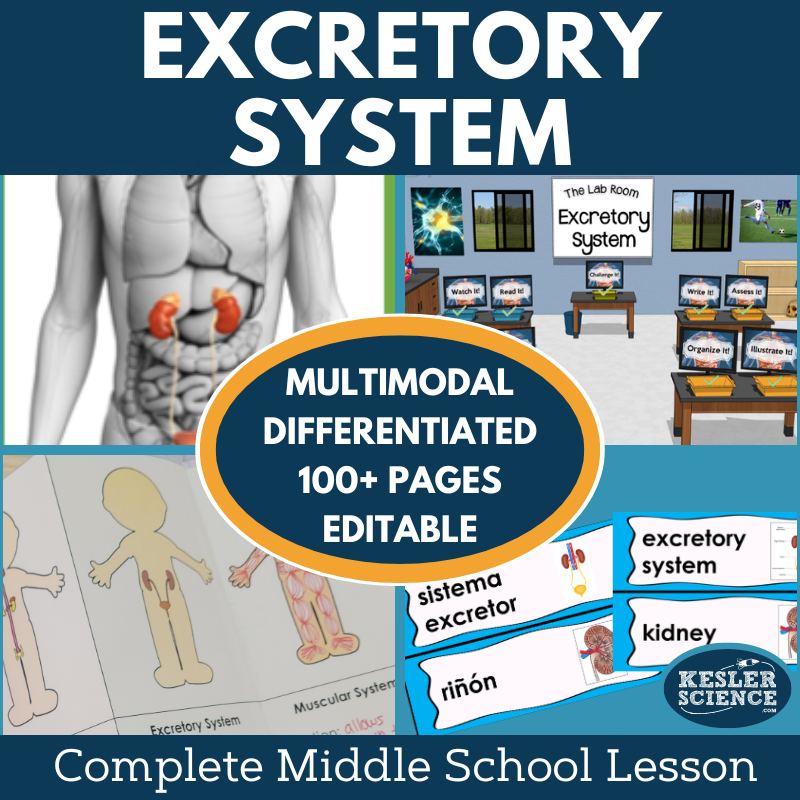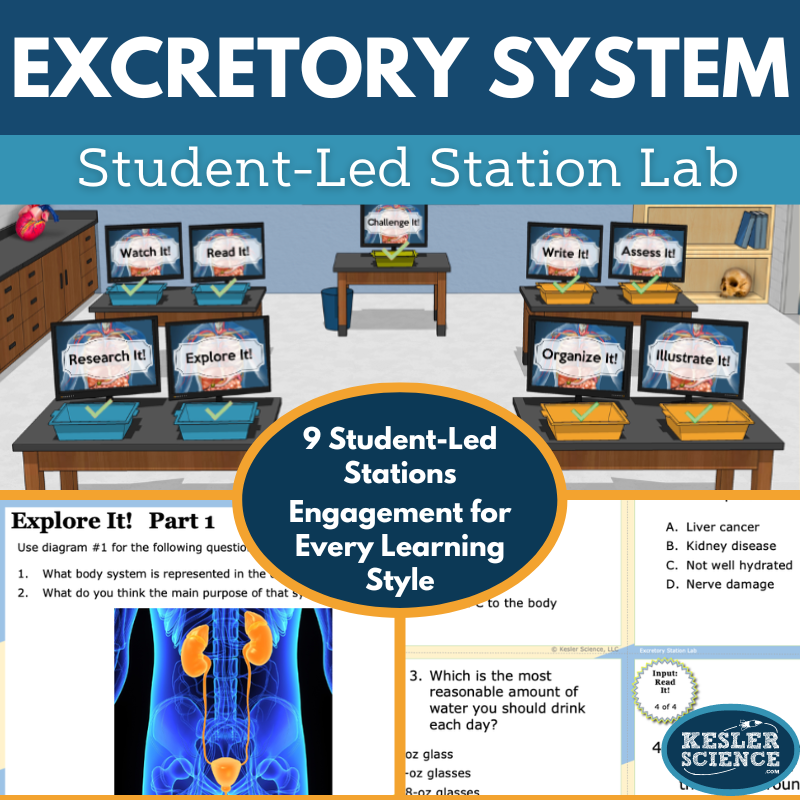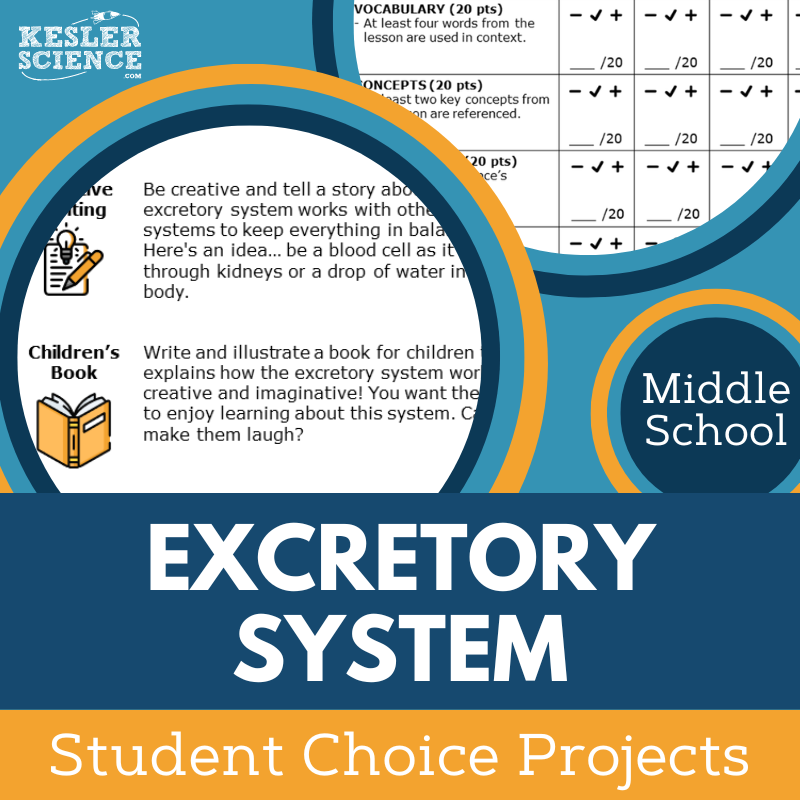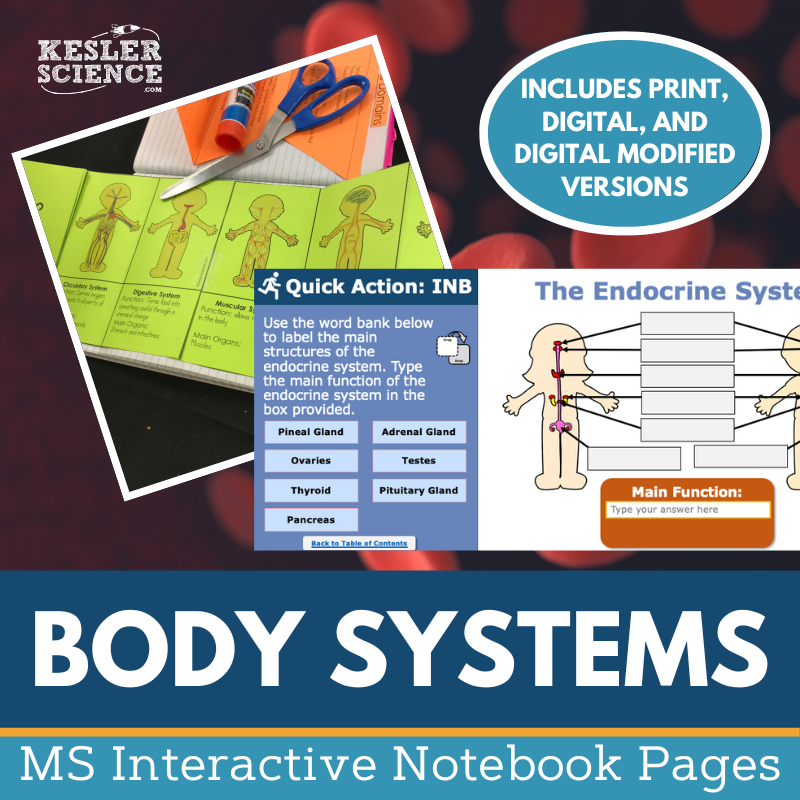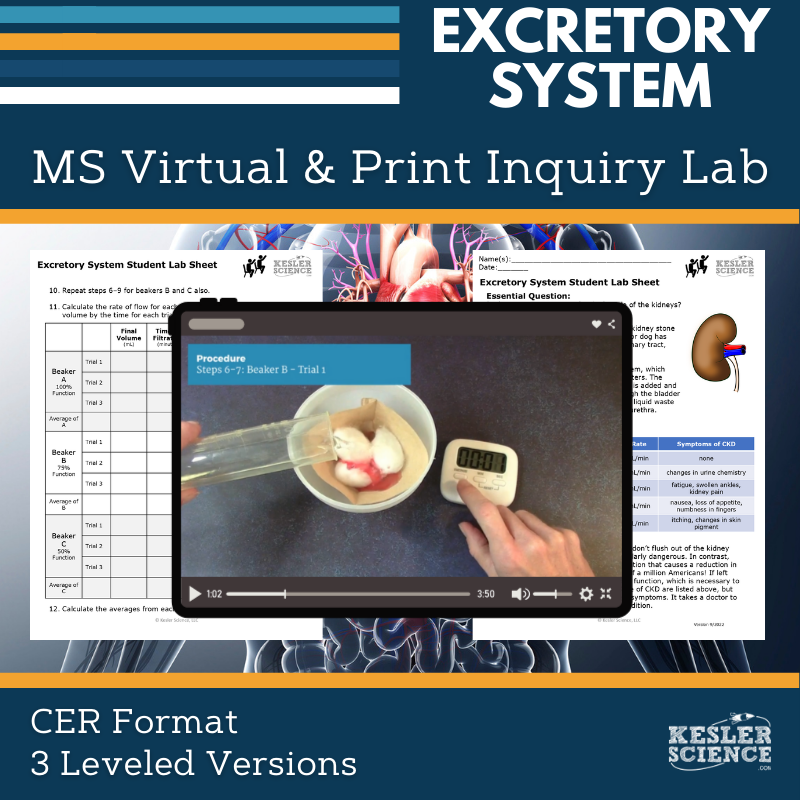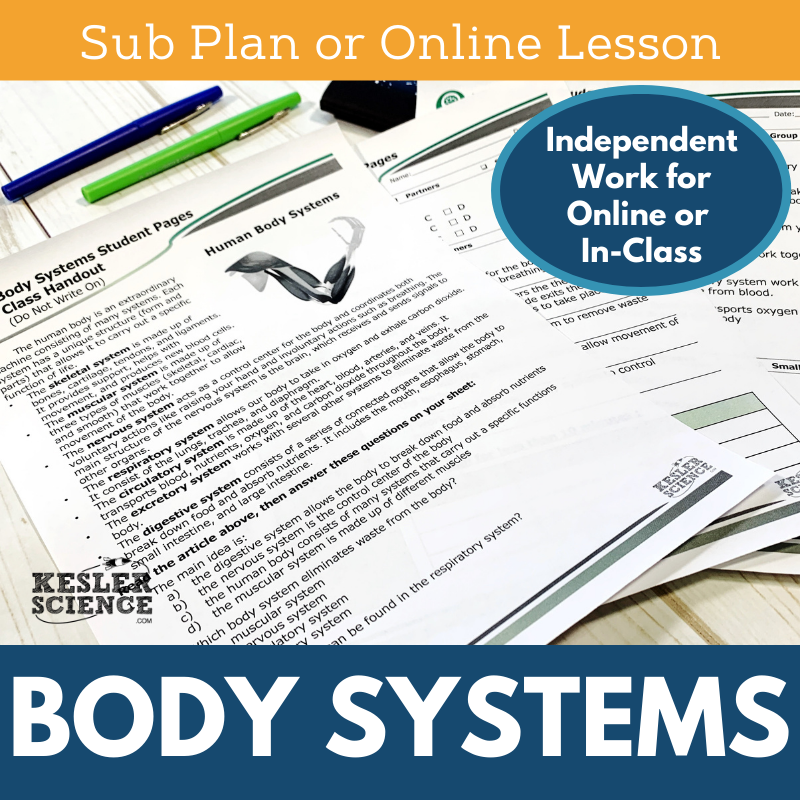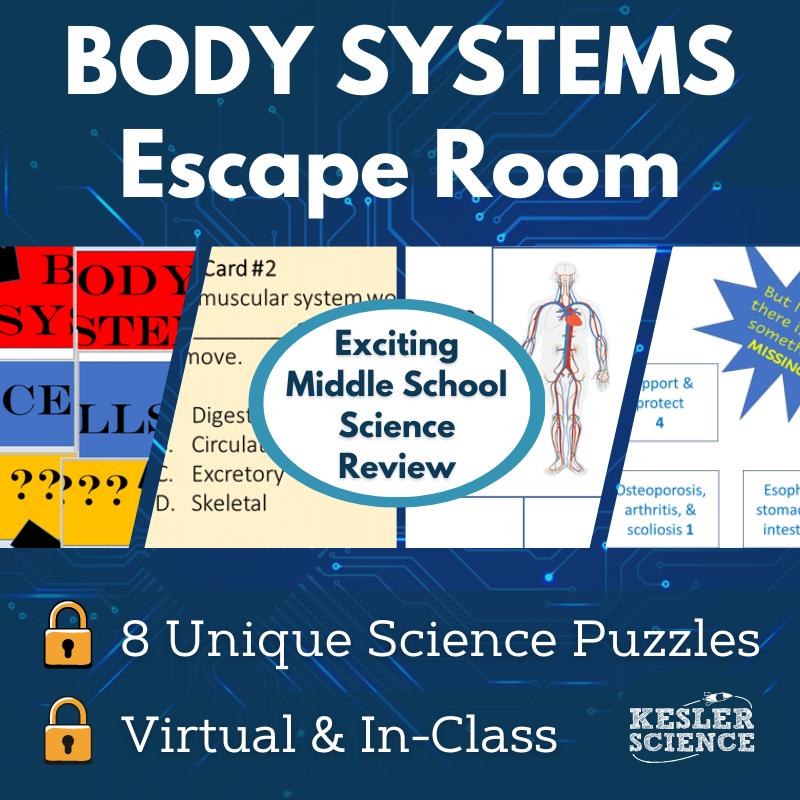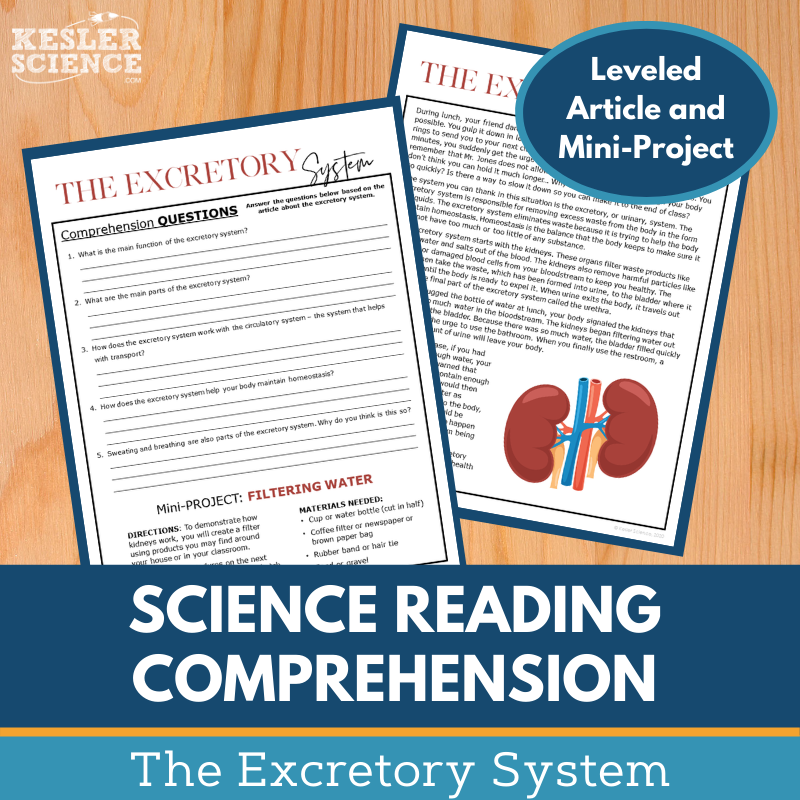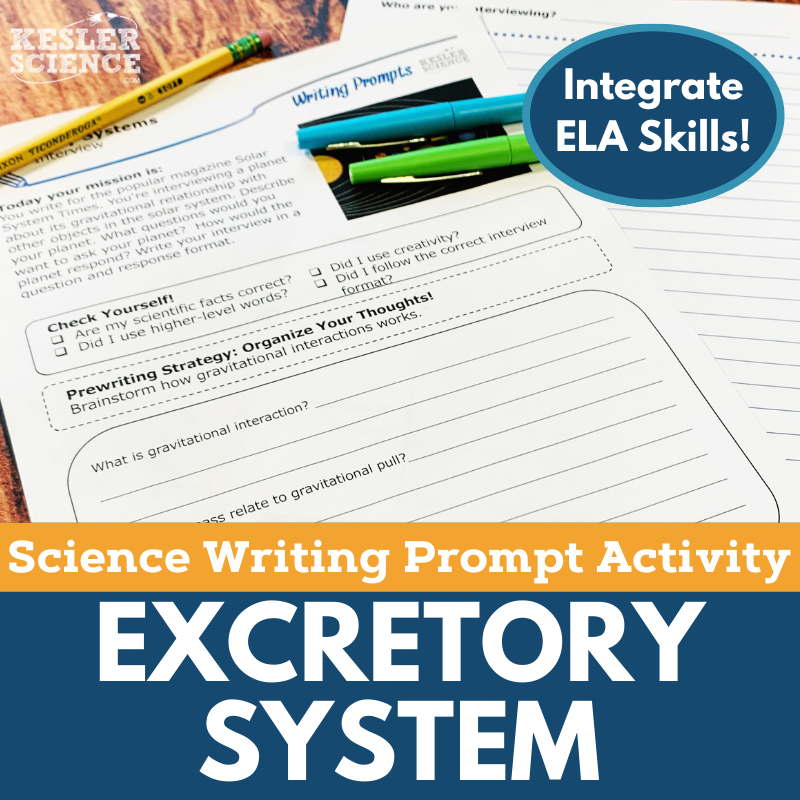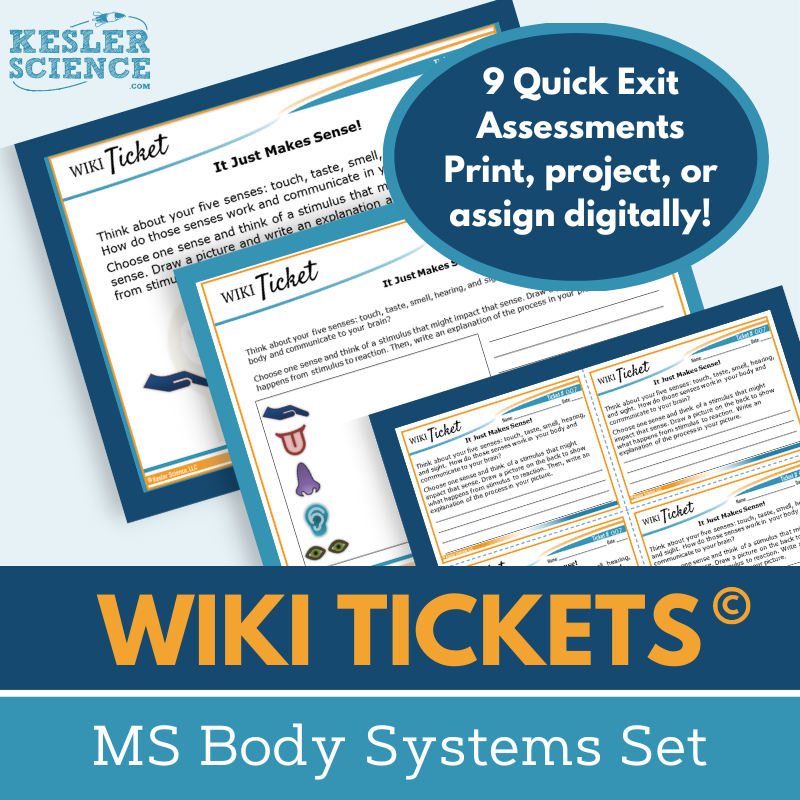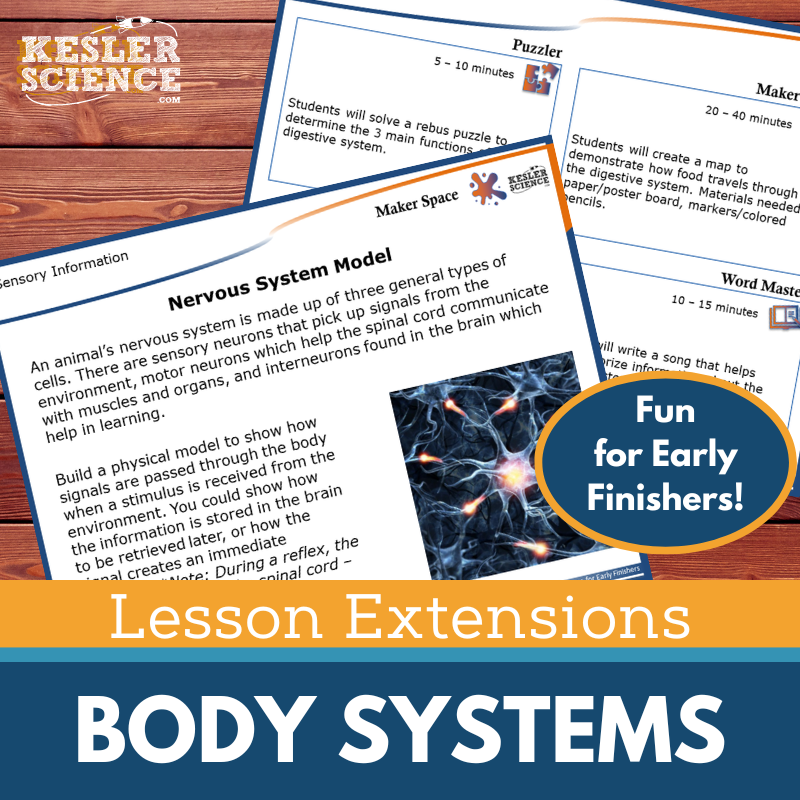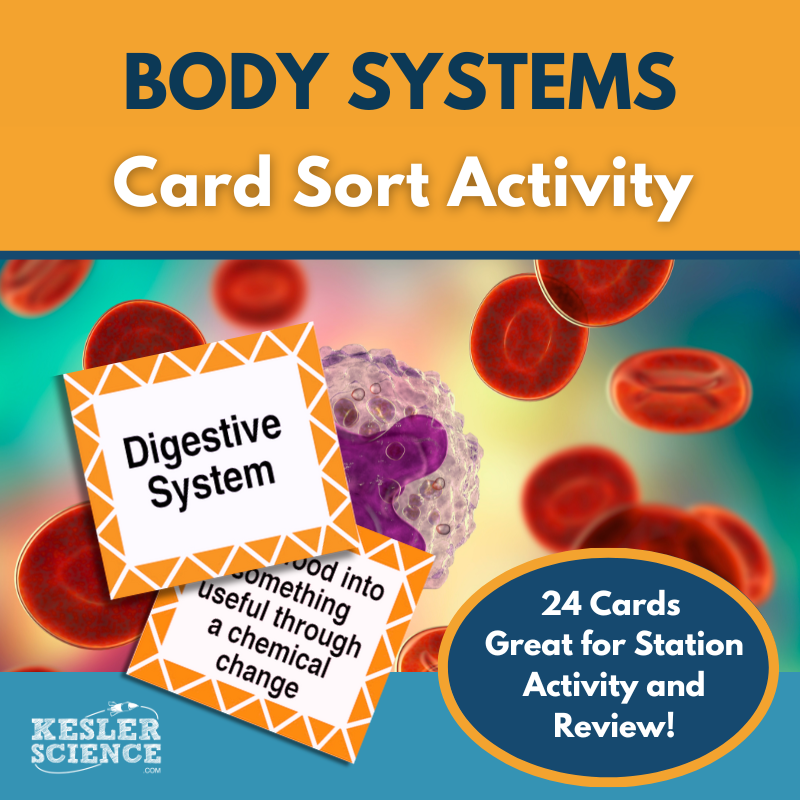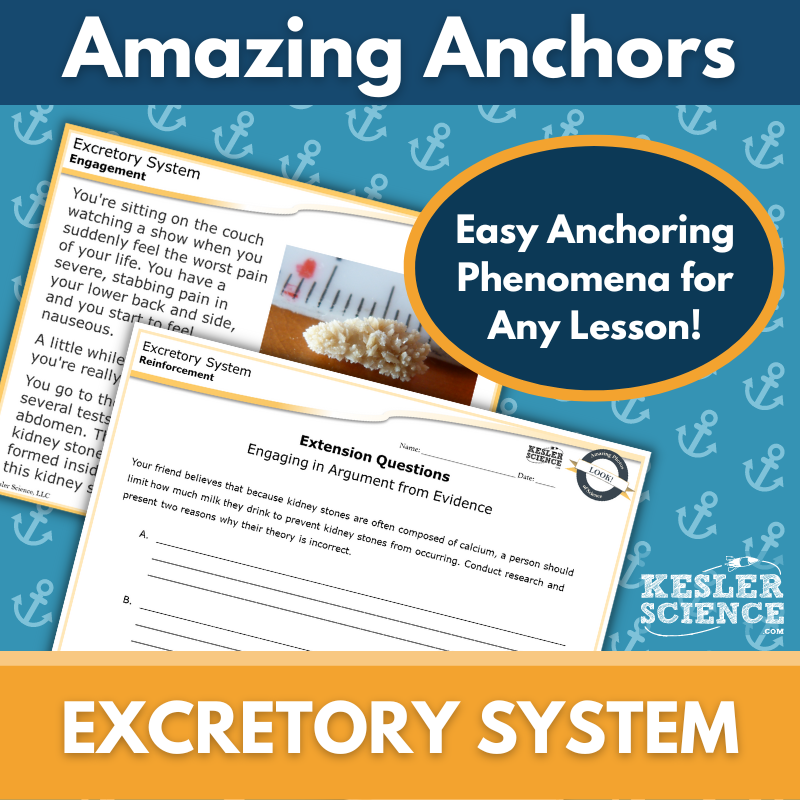Excretory System Activities for Middle School Science
The Kesler Science Excretory System resources provide a comprehensive, student-centered approach to teaching body systems with flexible, engaging lessons for middle school students. The resources below will give students a comprehensive understanding of excretory system. All of the following materials are also included in the Kesler Science Membership.
The Kesler Science Excretory System Complete 5E Lesson provides a full, engaging multi-day lesson plan for middle school students with minimal prep required. It focuses on the main function and organs of the excretory system, offering differentiated resources for various student needs. The lesson follows the 5E Model, guiding students through Engagement, Exploration, Explanation, Elaboration, and Evaluation.
In the Exploration phase, students interact with nine differentiated stations, which include activities like hands-on experiments, reading passages, videos, and research tasks. Output stations allow students to demonstrate their learning through writing, illustrations, and categorization. A bonus station provides advanced students with challenge activities to extend their understanding.
The lesson is flexible and can be used both in-person and virtually, with editable PowerPoints, interactive notebook templates, and Spanish translations. This comprehensive resource is designed to keep students engaged while promoting independent, student-led learning.
The Kesler Science Excretory System Complete 5E Lesson provides a full, engaging multi-day lesson plan for middle school students with minimal prep required. It focuses on the main function and organs of the excretory system, offering differentiated resources for various student needs. The lesson follows the 5E Model, guiding students through Engagement, Exploration, Explanation, Elaboration, and Evaluation.
In the Exploration phase, students interact with nine differentiated stations, which include activities like hands-on experiments, reading passages, videos, and research tasks. Output stations allow students to demonstrate their learning through writing, illustrations, and categorization. A bonus station provides advanced students with challenge activities to extend their understanding.
The lesson is flexible and can be used both in-person and virtually, with editable PowerPoints, interactive notebook templates, and Spanish translations. This comprehensive resource is designed to keep students engaged while promoting independent, student-led learning.
The Kesler Science Excretory System Station Lab is a student-led, modular activity designed to engage middle school students while they explore the excretory system. The nine differentiated stations allow students to learn through various methods, including hands-on demonstrations, reading, research, videos, and creative tasks, all while facilitating independent learning.
Each station features a unique activity, such as organizing information with manipulatives, illustrating concepts, writing responses, and assessing knowledge through task cards. A challenge station for advanced students provides additional opportunities for enrichment. Materials needed are minimal and mostly already available in the classroom.
These resources are designed to be flexible, allowing for use in both in-person and virtual learning environments, ensuring maximum engagement and learning opportunities for all students.
The Kesler Science Excretory System Station Lab is a student-led, modular activity designed to engage middle school students while they explore the excretory system. The nine differentiated stations allow students to learn through various methods, including hands-on demonstrations, reading, research, videos, and creative tasks, all while facilitating independent learning.
Each station features a unique activity, such as organizing information with manipulatives, illustrating concepts, writing responses, and assessing knowledge through task cards. A challenge station for advanced students provides additional opportunities for enrichment. Materials needed are minimal and mostly already available in the classroom.
These resources are designed to be flexible, allowing for use in both in-person and virtual learning environments, ensuring maximum engagement and learning opportunities for all students.
The Kesler Science Excretory System Student Choice Projects offer middle school students the opportunity to choose from six project options or create their own, allowing for personalized and creative learning. A flexible grading rubric supports assessments by teachers, peers, or students themselves.
The project options include nine different activities, with differentiated versions to support diverse learning needs. Teachers can modify the rubric for various grading requirements, ensuring flexibility across different student abilities.
Students can use everyday classroom supplies such as paper, markers, and scissors, with many projects also suitable for digital formats. The student-centered approach fosters creativity and independent learning, making it ideal for any class.
The Kesler Science Excretory System Student Choice Projects offer middle school students the opportunity to choose from six project options or create their own, allowing for personalized and creative learning. A flexible grading rubric supports assessments by teachers, peers, or students themselves.
The project options include nine different activities, with differentiated versions to support diverse learning needs. Teachers can modify the rubric for various grading requirements, ensuring flexibility across different student abilities.
Students can use everyday classroom supplies such as paper, markers, and scissors, with many projects also suitable for digital formats. The student-centered approach fosters creativity and independent learning, making it ideal for any class.
The Kesler Science Body Systems Interactive Notebook Bundle provides a hands-on and engaging way for students to learn about body systems, offering both print and digital options for flexible use in traditional classrooms, 1:1 settings, or distance learning environments. Students can explore key systems, such as the circulatory, digestive, and nervous systems, while interacting with customized templates and reflection pages to enhance understanding.
The digital version features an interactive PowerPoint file that can be uploaded to Google Slides or other platforms like MS Teams or Canvas, making it easy to assign and complete remotely. Students can add notes, complete reflection activities, and access modified templates as needed. The teacher key and modified digital versions ensure accessibility for all learners.
The paper version includes blank and pre-filled templates, along with color photos for guidance, making it ideal for interactive notebooks. This comprehensive bundle offers everything teachers need to support students’ mastery of body system concepts while catering to diverse learning needs.
The Kesler Science Body Systems Interactive Notebook Bundle provides a hands-on and engaging way for students to learn about body systems, offering both print and digital options for flexible use in traditional classrooms, 1:1 settings, or distance learning environments. Students can explore key systems, such as the circulatory, digestive, and nervous systems, while interacting with customized templates and reflection pages to enhance understanding.
The digital version features an interactive PowerPoint file that can be uploaded to Google Slides or other platforms like MS Teams or Canvas, making it easy to assign and complete remotely. Students can add notes, complete reflection activities, and access modified templates as needed. The teacher key and modified digital versions ensure accessibility for all learners.
The paper version includes blank and pre-filled templates, along with color photos for guidance, making it ideal for interactive notebooks. This comprehensive bundle offers everything teachers need to support students’ mastery of body system concepts while catering to diverse learning needs.
The Kesler Science Excretory System Inquiry Lab gives students the opportunity to explore how kidneys function by building a hands-on model that simulates varying levels of kidney health. Through this activity, students compare healthy and unhealthy kidney function and connect it to the excretory system’s role in maintaining overall health. The lab includes both a printable experiment and a fully virtual version with a demonstration video, comprehension checks, C.E.R. prompts, and a reflection section.
Each version of the lab is differentiated into three levels—dependent, modified, and independent—to support all learners. The dependent level includes guided instructions and inquiry questions, the modified level offers a highly structured format with supports like sentence stems, and the independent level encourages student-led exploration with minimal teacher direction.
The printable lab uses everyday materials like beakers, funnels, coffee filters, red food coloring, and cotton balls, while the virtual version requires no materials and includes interactive components and a pre-recorded procedure video. Editable files are provided for easy customization, and teacher resources include answer keys, preparation guidance, and standards alignment.
The Kesler Science Excretory System Inquiry Lab gives students the opportunity to explore how kidneys function by building a hands-on model that simulates varying levels of kidney health. Through this activity, students compare healthy and unhealthy kidney function and connect it to the excretory system’s role in maintaining overall health. The lab includes both a printable experiment and a fully virtual version with a demonstration video, comprehension checks, C.E.R. prompts, and a reflection section.
Each version of the lab is differentiated into three levels—dependent, modified, and independent—to support all learners. The dependent level includes guided instructions and inquiry questions, the modified level offers a highly structured format with supports like sentence stems, and the independent level encourages student-led exploration with minimal teacher direction.
The printable lab uses everyday materials like beakers, funnels, coffee filters, red food coloring, and cotton balls, while the virtual version requires no materials and includes interactive components and a pre-recorded procedure video. Editable files are provided for easy customization, and teacher resources include answer keys, preparation guidance, and standards alignment.
The Kesler Science Body Systems Sub Plans guide students through an engaging sequence of activities, including a warm-up puzzle, a reading passage, and a hands-on project to create a booklet labeling the organs and functions of each body system. Using their booklets, students answer questions to deepen their understanding. Extension activities challenge early finishers to explore how systems like the skeletal and muscular systems work together or how multiple systems collaborate to digest a meal. The lesson concludes with an assessment or exit ticket.
Comprehensive support is provided for both in-class and distance learning formats, including substitute teacher instructions, a Google Form answer sheet, and editable resources. Each lesson is thoughtfully crafted to minimize downtime, with substitute directions, behavior checkpoints, and engaging activities to ensure a productive day. Digital versions allow students to annotate PDFs or submit answers online, making the resource versatile for remote or in-person use.
These middle school science sub plans are perfect for days when teachers are out, offering clear instructions for substitutes and meaningful, student-centered activities. They are also ideal for homework, extra credit, or small group sessions. Packed with editable documents, answer keys, and flexible learning formats, these plans make managing classroom learning seamless and stress-free.
The Kesler Science Body Systems Sub Plans guide students through an engaging sequence of activities, including a warm-up puzzle, a reading passage, and a hands-on project to create a booklet labeling the organs and functions of each body system. Using their booklets, students answer questions to deepen their understanding. Extension activities challenge early finishers to explore how systems like the skeletal and muscular systems work together or how multiple systems collaborate to digest a meal. The lesson concludes with an assessment or exit ticket.
Comprehensive support is provided for both in-class and distance learning formats, including substitute teacher instructions, a Google Form answer sheet, and editable resources. Each lesson is thoughtfully crafted to minimize downtime, with substitute directions, behavior checkpoints, and engaging activities to ensure a productive day. Digital versions allow students to annotate PDFs or submit answers online, making the resource versatile for remote or in-person use.
These middle school science sub plans are perfect for days when teachers are out, offering clear instructions for substitutes and meaningful, student-centered activities. They are also ideal for homework, extra credit, or small group sessions. Packed with editable documents, answer keys, and flexible learning formats, these plans make managing classroom learning seamless and stress-free.
The Kesler Science Body Systems Escape Room provides an immersive, hands-on way for students to demonstrate their understanding of major body systems, their structures, and their functions. With eight unique puzzles, teachers have full control over the activities, choosing which puzzles to use and their order—perfect for adapting to different class lengths. This engaging activity combines critical thinking, teamwork, and science content into a memorable classroom experience.
The escape room can be run using simple materials like manila envelopes or with more authentic props, including locks and a storage box, for a realistic feel. Both physical and digital versions are available, offering flexibility for in-person or virtual learning. Digital versions include editable PowerPoints and Google Slides, while printable materials support at-home or classroom setups. Tools like UV pens, red cellophane, and mirrors add to the fun, but alternatives are provided for cost-effective implementation.
The product includes everything needed for a smooth experience: teacher directions, a detailed answer key, a digital answer sheet, editable templates, a mood-setting video challenge, printable props, reward templates, and over 50 prize ideas. Whether used in a physical or digital format, the Kesler Science Escape Room is an engaging and versatile resource for reinforcing body systems knowledge.
The Kesler Science Body Systems Escape Room provides an immersive, hands-on way for students to demonstrate their understanding of major body systems, their structures, and their functions. With eight unique puzzles, teachers have full control over the activities, choosing which puzzles to use and their order—perfect for adapting to different class lengths. This engaging activity combines critical thinking, teamwork, and science content into a memorable classroom experience.
The escape room can be run using simple materials like manila envelopes or with more authentic props, including locks and a storage box, for a realistic feel. Both physical and digital versions are available, offering flexibility for in-person or virtual learning. Digital versions include editable PowerPoints and Google Slides, while printable materials support at-home or classroom setups. Tools like UV pens, red cellophane, and mirrors add to the fun, but alternatives are provided for cost-effective implementation.
The product includes everything needed for a smooth experience: teacher directions, a detailed answer key, a digital answer sheet, editable templates, a mood-setting video challenge, printable props, reward templates, and over 50 prize ideas. Whether used in a physical or digital format, the Kesler Science Escape Room is an engaging and versatile resource for reinforcing body systems knowledge.
The Kesler Science Excretory System Reading Comprehension Activity engages middle school students with a nonfiction article that explores the structures and functions of the excretory system. After reading, students complete comprehension questions and create a filter model to represent how the system works. This hands-on project reinforces their learning and builds science literacy.
The resource includes two leveled articles with corresponding questions and activities, designed for students in grades 6-8 (and advanced 5th graders). It also includes a Cornell notes template and colorful graphics, which can be printed in grayscale. This lesson is adaptable for both in-person and virtual learning environments, allowing students to respond in platforms like Google Slides or PowerPoint.
This activity supports science literacy, aids in building textual analysis skills, and works well for absences, sub plans, or whole-class instruction. It is also perfect for fostering classroom discussions and can be used to enhance science reading comprehension or as an ongoing assignment throughout a unit.
The Kesler Science Excretory System Reading Comprehension Activity engages middle school students with a nonfiction article that explores the structures and functions of the excretory system. After reading, students complete comprehension questions and create a filter model to represent how the system works. This hands-on project reinforces their learning and builds science literacy.
The resource includes two leveled articles with corresponding questions and activities, designed for students in grades 6-8 (and advanced 5th graders). It also includes a Cornell notes template and colorful graphics, which can be printed in grayscale. This lesson is adaptable for both in-person and virtual learning environments, allowing students to respond in platforms like Google Slides or PowerPoint.
This activity supports science literacy, aids in building textual analysis skills, and works well for absences, sub plans, or whole-class instruction. It is also perfect for fostering classroom discussions and can be used to enhance science reading comprehension or as an ongoing assignment throughout a unit.
The Excretory System science writing activity engages middle school students in a creative letter writing task that reinforces their understanding of life science concepts. Designed for both print and digital formats, this activity encourages students to apply their knowledge while strengthening science reasoning and communication skills. It works well in virtual or in-person classrooms, making it a flexible option for any learning environment.
Aligned with NGSS and TEKS standards, the prompt serves as an excellent review or extension tool. The resource includes teacher directions with answer guides, project ideas, and rubrics, as well as full-size and half-sheet handouts for student use. A digital version in PowerPoint and Google Slides is also provided, allowing students to complete the task interactively online.
This writing prompt can be used for a range of purposes, including cross-curricular projects, pre-test assessments, extra credit, student choice assignments, and TELPAS samples. It is ideal for early finishers or differentiated instruction, and the final products are perfect for classroom display or compilation into a student writing anthology.
The Excretory System science writing activity engages middle school students in a creative letter writing task that reinforces their understanding of life science concepts. Designed for both print and digital formats, this activity encourages students to apply their knowledge while strengthening science reasoning and communication skills. It works well in virtual or in-person classrooms, making it a flexible option for any learning environment.
Aligned with NGSS and TEKS standards, the prompt serves as an excellent review or extension tool. The resource includes teacher directions with answer guides, project ideas, and rubrics, as well as full-size and half-sheet handouts for student use. A digital version in PowerPoint and Google Slides is also provided, allowing students to complete the task interactively online.
This writing prompt can be used for a range of purposes, including cross-curricular projects, pre-test assessments, extra credit, student choice assignments, and TELPAS samples. It is ideal for early finishers or differentiated instruction, and the final products are perfect for classroom display or compilation into a student writing anthology.
The Kesler Science WIKI Tickets provide engaging, flexible formative assessments for 6th–8th grade science topics, designed to check student understanding in a fun and interactive way. Aligned with NGSS and TEKS standards, these assessments cover nine body systems, including the circulatory, digestive, endocrine, excretory, muscular, nervous, respiratory, and skeletal systems, as well as sensory information. Each topic includes five formats: projection, full-page, split-page, quarter-page handouts, and editable digital versions for use in PowerPoint or Google Slides.
These colorful WIKI Tickets can be used as exit tickets, bellringers, or quick checks for learning progress. Teachers have the flexibility to use them in print, project them for whole-class responses, or assign them digitally for 1:1 and virtual settings. A bonus table of contents file shows the alignment of each ticket to middle school science standards, ensuring comprehensive coverage of key concepts.
Perfect for both in-person and remote learning, the WIKI Tickets make lesson planning easier while keeping students engaged and on track. These versatile tools ensure you're prepared to assess understanding in any learning environment.
The Kesler Science WIKI Tickets provide engaging, flexible formative assessments for 6th–8th grade science topics, designed to check student understanding in a fun and interactive way. Aligned with NGSS and TEKS standards, these assessments cover nine body systems, including the circulatory, digestive, endocrine, excretory, muscular, nervous, respiratory, and skeletal systems, as well as sensory information. Each topic includes five formats: projection, full-page, split-page, quarter-page handouts, and editable digital versions for use in PowerPoint or Google Slides.
These colorful WIKI Tickets can be used as exit tickets, bellringers, or quick checks for learning progress. Teachers have the flexibility to use them in print, project them for whole-class responses, or assign them digitally for 1:1 and virtual settings. A bonus table of contents file shows the alignment of each ticket to middle school science standards, ensuring comprehensive coverage of key concepts.
Perfect for both in-person and remote learning, the WIKI Tickets make lesson planning easier while keeping students engaged and on track. These versatile tools ensure you're prepared to assess understanding in any learning environment.
The Kesler Science Body Systems Lesson Extensions provide student-choice activities designed to challenge early finishers and deepen their understanding of body systems through engaging, creative, and rigorous learning opportunities. These activities are perfect for ending lessons, filling testing gaps, or keeping students focused with NGSS- and TEKS-aligned content. Students can explore critical thinking and creativity through puzzles, STEAM-based maker activities, digital media projects, and creative writing tasks.
Each extension includes teacher directions, answer keys, projection options for digital boards, and printable handouts in full- and half-sheet formats. Topics covered include the circulatory, digestive, endocrine, excretory, integumentary, muscular, nervous, respiratory, and skeletal systems, as well as sensory information, making them a perfect supplement for anatomy and physiology units.
Kesler Science Lesson Extensions help scaffold learning for independent learners, offering a variety of high-level activities to enhance problem-solving, creativity, and hands-on engagement, all while maintaining alignment with key science standards.
The Kesler Science Body Systems Lesson Extensions provide student-choice activities designed to challenge early finishers and deepen their understanding of body systems through engaging, creative, and rigorous learning opportunities. These activities are perfect for ending lessons, filling testing gaps, or keeping students focused with NGSS- and TEKS-aligned content. Students can explore critical thinking and creativity through puzzles, STEAM-based maker activities, digital media projects, and creative writing tasks.
Each extension includes teacher directions, answer keys, projection options for digital boards, and printable handouts in full- and half-sheet formats. Topics covered include the circulatory, digestive, endocrine, excretory, integumentary, muscular, nervous, respiratory, and skeletal systems, as well as sensory information, making them a perfect supplement for anatomy and physiology units.
Kesler Science Lesson Extensions help scaffold learning for independent learners, offering a variety of high-level activities to enhance problem-solving, creativity, and hands-on engagement, all while maintaining alignment with key science standards.
The Body Systems Card Sort activity helps students learn about the ten major human body systems by sorting them based on their system name, main function, and major organs. This engaging activity can be used during instruction, as a review game, or for intervention and tutoring, providing a fun alternative to traditional study methods.
The body systems included are circulatory, skeletal, endocrine, muscular, integumentary, nervous, digestive, excretory, respiratory, and reproductive. This resource is suitable for any middle school students studying body systems.
The Body Systems Card Sort activity helps students learn about the ten major human body systems by sorting them based on their system name, main function, and major organs. This engaging activity can be used during instruction, as a review game, or for intervention and tutoring, providing a fun alternative to traditional study methods.
The body systems included are circulatory, skeletal, endocrine, muscular, integumentary, nervous, digestive, excretory, respiratory, and reproductive. This resource is suitable for any middle school students studying body systems.
This Amazing Anchors Phenomenon Lesson introduces the excretory system through a real-world lens with a focus on kidney stones. It begins with an introductory reading that highlights the experience of kidney stones to spark student interest and includes comprehension and extension questions to deepen understanding before the main lesson.
Following the introduction, an explanatory reading breaks down the structure and function of the excretory system, specifically how it relates to the formation and elimination of kidney stones. Students continue learning through a second set of comprehension and reinforcement questions that clarify key scientific concepts in a student-friendly format.
This no-prep resource includes teacher directions with answer keys, editable print and digital formats for LMS use, and both full- and half-page handouts. Differentiated versions are included to support all learners, with a modified reading that provides sentence starters and simplified language for accessibility. Designed to bookend instruction, these materials are ideal for the Engagement and Elaborate phases of the 5E model.
This Amazing Anchors Phenomenon Lesson introduces the excretory system through a real-world lens with a focus on kidney stones. It begins with an introductory reading that highlights the experience of kidney stones to spark student interest and includes comprehension and extension questions to deepen understanding before the main lesson.
Following the introduction, an explanatory reading breaks down the structure and function of the excretory system, specifically how it relates to the formation and elimination of kidney stones. Students continue learning through a second set of comprehension and reinforcement questions that clarify key scientific concepts in a student-friendly format.
This no-prep resource includes teacher directions with answer keys, editable print and digital formats for LMS use, and both full- and half-page handouts. Differentiated versions are included to support all learners, with a modified reading that provides sentence starters and simplified language for accessibility. Designed to bookend instruction, these materials are ideal for the Engagement and Elaborate phases of the 5E model.
Year-Round Resources
These year-round activities will increase your students' understanding of many middle school science topics. All of these activities are also included in the Kesler Science Membership.
Visual Data & Graphing
You're not alone if your students struggle with understanding graphs, charts, and tables. It's a skill that takes an enormous amount of practice. This resource will help students build a strong foundation in analyzing data and creating their own data visualizations.
Bell Ringers and Warm-Ups
These middle school science bell ringers are an excellent way to engage your students as soon as they walk into your classroom. This comprehensive FULL YEAR resource includes everything you need to start off each science class with an interesting warm-up activity.
Review Board Games
Each game board has been carefully designed to keep students engaged. There are 10 different action spaces on each board and dozens of question cards. All of the actions are related to science concepts and keep the students motivated throughout the game.
Each game is ready to play. Simply print out the board and the cards and let the students enjoy reviewing nine different units.
Essential Questions
Below are the essential questions associated with the lessons and activities included in this unit. This topic is only one of more than 100 middle school science topics included in the Kesler Science Membership.
-
What is the main function of the excretory system and how is it structured?
-
What are the main organs associated with this system?
Kesler Science Membership
Imagine never having to search for another middle school science lesson again. The membership gives you access to ALL of the Kesler Science products in one place (Yes, including everything above).
Say goodbye to long hours of lesson prep.

